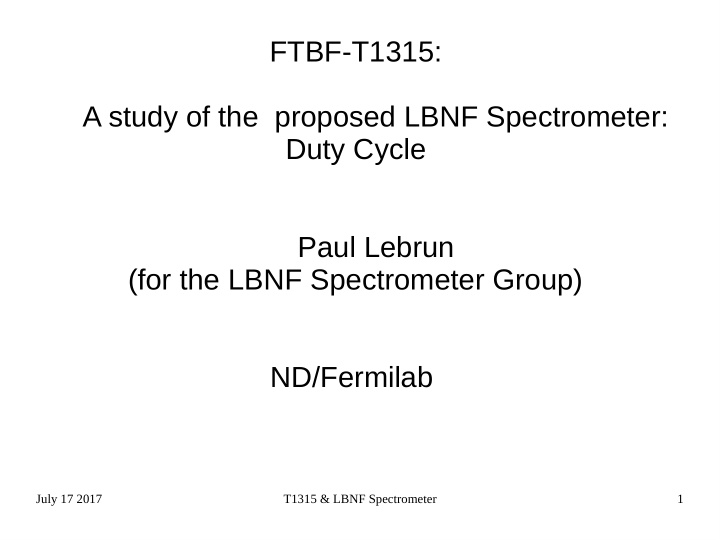



FTBF-T1315: A study of the proposed LBNF Spectrometer: Duty Cycle Paul Lebrun (for the LBNF Spectrometer Group) ND/Fermilab July 17 2017 T1315 & LBNF Spectrometer 1
Context: The LBNF neutrino beam, and the LBNF Spectrometer We proposed a direct measurement of the neutrino's progenitor flux (pions, kaons, muons) in a replica of the real LBNF chase in order to constraint the uncertainties in precision studies of neutrino oscillation. ● This measurement could be done at a Fermilab Fixed target beamline, using spare “hot spare” parts for the target/focusing components and existing technologies for the spectrometer. July 17 2017 T1315 & LBNF Spectrometer 2
The LBNF Spectrometer Concept, “Ex-situ” Different architectures possible... Credits: Laura Fields July 17 2017 T1315 & LBNF Spectrometer 3
LBNF duty cycle:brief introduction A direct measurement of the neutrino's progenitors, with the target, and the focusing system turned “on” implies a stringent upper limit on the duty cycle of the spectrometer: About 6x5.e -5 /60, or ~ 5e -6 . The first term is the number of pulses per 4.1 second M.I. spill the LBNF power horn power supply can deliver, the 2 nd term is the horn pulse duration, at “reasonable” flat top, when we have the near nominal focusing field, and the last term is M.I. fixed target inter-spill duration, 60 secs. If a statistical precision of ~ 1% for a small aperture which covers only ~1% of the total aperture (1.6 m 2 ), we need 1 e6 pions. Running at 20 MHz, it will take less than a day to take the data, assuming that (I) one proton per 50 ns long “time unit” (ii) assuming a “perfectly smooth spill”, one proton per time bin ==> only a loss of ~ 36%, based on Poisson statistics. Is this a correct assumption? As shown later, we could be off by a factor ten.. As we plan to so such measurement many times.. July 17 2017 T1315 & LBNF Spectrometer 4
Introduction: Aren't we aware of this ? Yes, Fixed target spill “smoothness”, “super -buckets” issues have been discussed since (almost) 50 years.. in particular SeaQuest has characterized their intensity (or “spill”) duty factor quite accurately. AD made numerous improvements But.. It is beam line and intensity dependent ! With the SeaQuest and FTBF expertise, we (LBNF spectrometer people) are learning the technique/method ==> T1315 July 17 2017 T1315 & LBNF Spectrometer 5
T1315: The equipment.. Mostly a Beam study! Detectors Standard Plastic Scintillator counters. ● Trigger: ● Simple coincidence between these counters, after discrimination, and the spill time window. Negligible false trigger. ● DAQ : ● DSR4 module for calibration of a single minimum ionizing particle (MIP) , search for “2 or more 120 GeV/ 53 MHz r.f. bucket” ● NimPlus/Captan board for recording the time of arrival of every trigger in a spill (only 2-bit to characterize each incoming beam particle), at 320 MHz, and write this data for every spill (100% efficient). July 17 2017 T1315 & LBNF Spectrometer 6
Credit : Rowan Zaki. July 17 2017 T1315 & LBNF Spectrometer 7
NimPlus board: time stamp Analysis The M.I. turn marker is also recorded (about 361,000/spill). We checked that 1/7 of them are empty (Abort gap) Poisson One can them study the trigger Observed multiplicity per arbitrary unit time, for instance, per M.I. turn. This for any given spill. Here, for shown for two consecutive spills, taken at ~ maximum T-Test intensity (~1.3 e6 counts on MT6SC1, 960 k triggers in our counters). So, we can compare this multiplicity distribution (histogram) to the “perfectly smooth distribution”, i.e., based the Poisson law (solid symbols) As expected, we see strong deviation at high multiplicity. Dune/LBNF preliminary work July 6 2017 Spectrometer Architecture & Duty Factor 8
Summary plot, Spectrometer Efficiency vs DAQ rate capability Requiring one, one only, incident proton/”pseudo bunch” Based on NimPLUs profile The “Rate” is the inverse of the (arbitrarily) chosen “time unit” or “pseudo bunch” duration. Reduced efficiency Since the FTBF is limited to ~ 1 10^6 particle per spill, our relevant range of rate is ~20 <Intensity> ~1 to time lower than what could be 1.4 10 6 counts/spill done for LBNF Spectrometer. Or <trig rate> 240 Yet, the optimum efficiency for to 340 kHz. “one and only one proton per pseudo bunch” is at lower rate, by a factor 10, or, Dune/LBNF preliminary work conversely, at the rate at which the mean occupancy is one, our effective efficiency is 10 ~ times lower then the one dictated by Poisson law. DAQ rate [Hz] July 17 2017 T1315 & LBNF Spectrometer 9
Conclusions The duty cycle due inherent intensity fluctuations can be characterized for arbitrary time scales (MHz → kHz) Assuming that the LBNF Spectrometer primary beam line, the Fixed Target Switch yard, the Main Injector perform as they did during the F.Y. 2017 run, then, the LBNF spectrometer options should (conservatively) be considered keeping in mind that the duty cycle could be a factor 10 lower than the one dictated by a “perfectly smooth” spill hypothesis. If we require one and only proton per pseudo-bucket... We may have to compromise!. Coming Next: Fast tracking/PID studies in F.Y. 18/F.Y 19. July 6 2017 Spectrometer Architecture & Duty Factor 10
Acknowledgments This effort would not have been possible without the dedicated help from Mandy K. Rominsky, Eugene Schmidt, Todd Nebel, Anatoly Ronzhin Paul Rubinov, Sten Hansen (PPD), Rick Tesarek (ND), Alan Prosser, Ryan A. Rivera (SCD) Many thanks! July 6 2017 Spectrometer Architecture & Duty Factor 11
Recommend
More recommend